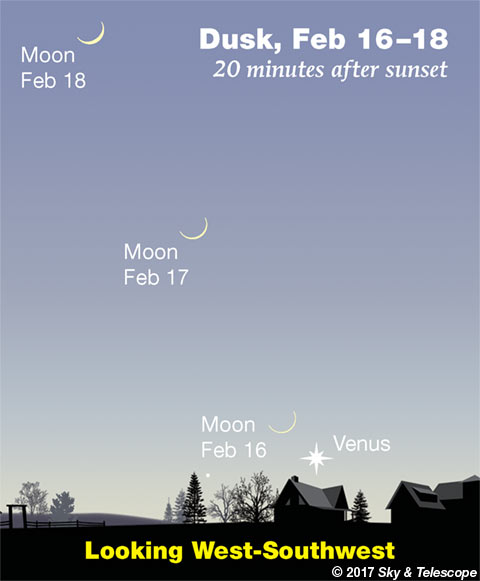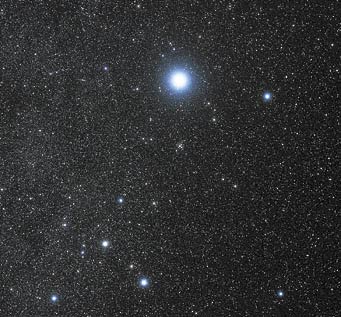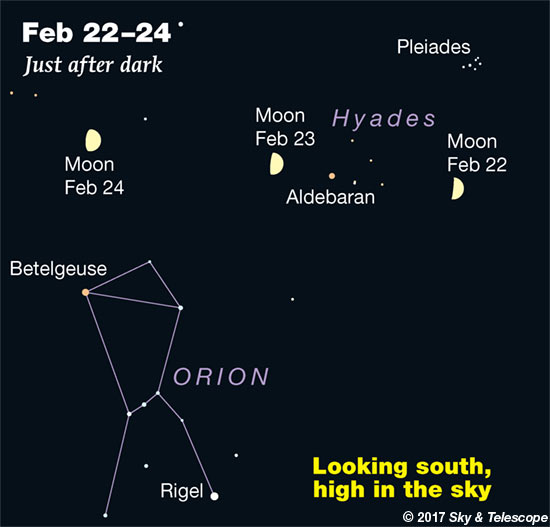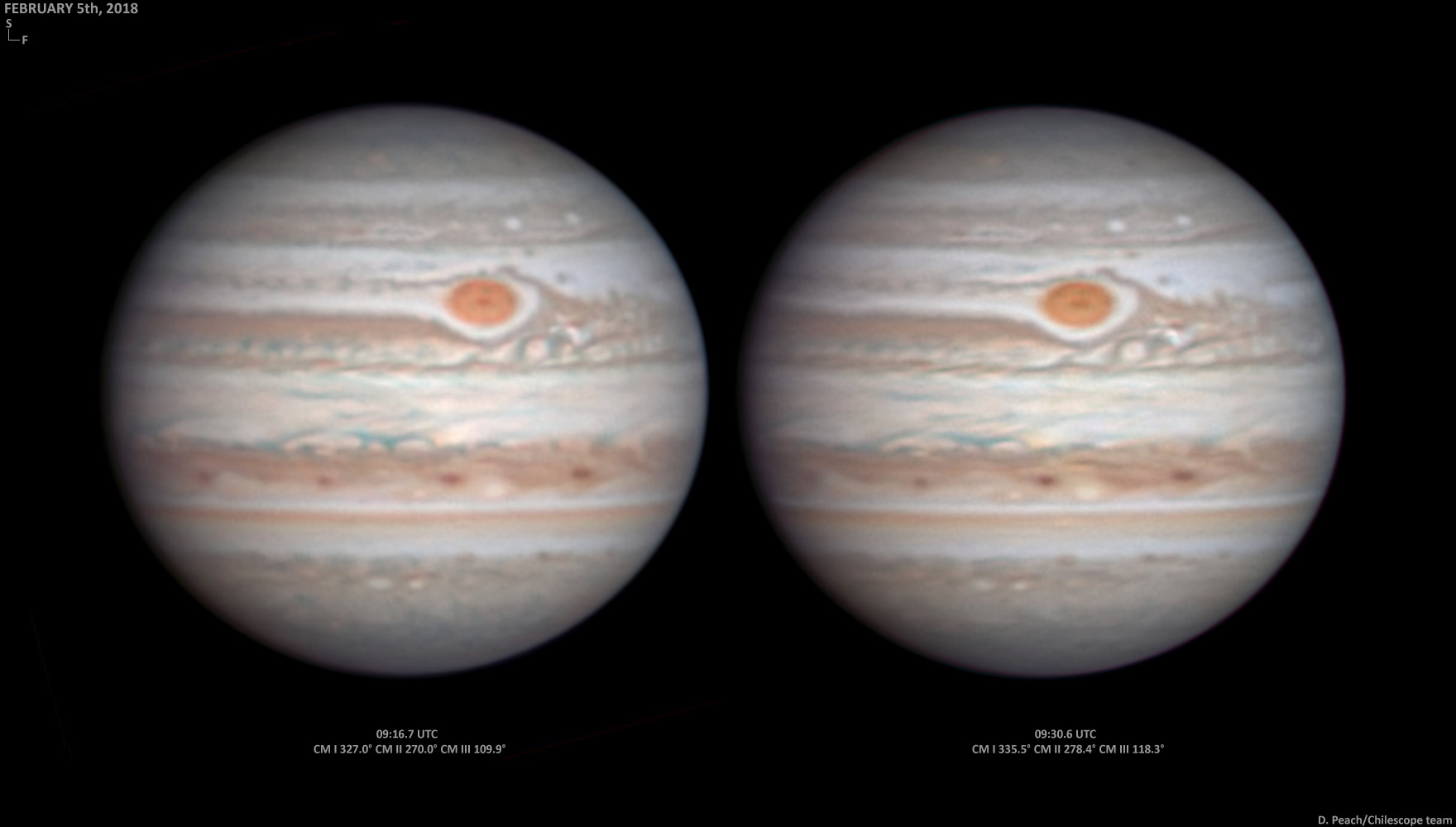
Friday, February 16
• About 15 to 20 minutes after sunset, use binoculars to look just above the west-southwest horizon for Venus and a super-thin crescent Moon, as shown at right. The crescent is only a little more than 24 hours old for North America; new Moon was yesterday at 4:04 p.m. EST.
Saturday, February 17
• Now the waxing crescent Moon is easier to see in the west-southwest after sunset. Its curved side points the way down toward Venus this evening and tomorrow, as shown at right.
Sunday, February 18
• During February, Orion stands high in the south after dinnertime. Lower left of it blazes Sirius, and farther left of Orion shines Procyon. Extending up from Procyon is dim little Canis Minor: the doglet whose top is barely visible in profile in a dark sky. He's currently vertical; Procyon is his rump. We only see stars marking the profile outline of his back (from Procyon up to 3rd-magnitude Gomeisa) and the back of his head (Gamma and Epsilon Canis Minoris just above Gomeisa, faint at 4th and 5th magnitude).
Monday, February 19
• If the Big Dipper stands upright in the northeast, can Bootes be far behind? The Dipper's handle famously arcs down and around toward Arcturus, the lucida (brightest star) of Bootes — and the arc crosses Bootes for most of the way. The whole constellation is above the east-northeast horizon by about 10 p.m. now. Spring approaches.
Tuesday, February 20
• After it's fully dark, look 15° (about a fist and a half at arm's length) upper right of the Moon for Hamal, the brightest star of Aries. The next two brightest stars of Aries, Sheratan and Mesarthim, hang below Hamal.
Continue the line from the Moon through Hamal onward by another fist (if you're observing from North America), and you're in dim Triangulum: long, thin, and pointing down.

Wednesday, February 21
• Sirius blazes high in the south on the meridian by 8 or 9 p.m. now. Using binoculars, examine the spot 4° south of Sirius: directly below it when on the meridian. Four degrees is somewhat less than the width of a typical binocular's field of view. Can you see an irregular little patch of gray haze? That's the open star cluster M41, about 2,200 light-years away. Sirius, by comparison, is only 8.6 light-years away.

Thursday, February 22
• The Moon this evening shines with Aldebaran and the Pleiades, as shown in twilight to the lower right.
• Under the feet of Orion, and to the right of Sirius now, hides Lepus the Hare. As with Canis Major, you can connect Lepus's dots to make it look like what it's supposed to be. He's a crouching bunny, with his nose pointing lower right, his faint ears extending up toward Rigel, and his body bunched to the left. His brightest two stars, 3rd-magnitude Beta and Alpha Leporis, form the front and back of his neck.
Friday, February 23
• First-quarter Moon (exact at 3:09 a.m. on this date EST). For North America this evening the Moon shines left or upper left of Aldebaran, and farther upper right of Orion, as shown here.
The Moon occults Aldebaran in daylight or twilight for northern and western Europe, and in darkness for much of Russia; map and timetables.
Saturday, February 24
• The Moon shines over Orion after dark, as shown here.
• Algol should be at minimum brightness, magnitude 3.4 instead of its usual 2.1, for a couple hours centered on 10:05 p.m. EST (7:05 p.m. PST).
________________________
Want to become a better astronomer? Learn your way around the constellations! They're the key to locating everything fainter and deeper to hunt with binoculars or a telescope.
This is an outdoor nature hobby. For an easy-to-use constellation guide covering the whole evening sky, use the big monthly map in the center of each issue of Sky & Telescope, the essential guide to astronomy.

Once you get a telescope, to put it to good use you'll need a detailed, large-scale sky atlas (set of charts). The basic standard is the Pocket Sky Atlas (in either the original or Jumbo Edition), which shows stars to magnitude 7.6.
Next up is the larger and deeper Sky Atlas 2000.0, plotting stars to magnitude 8.5; nearly three times as many. The next up, once you know your way around, is the even larger Uranometria 2000.0 (stars to magnitude 9.75). And read how to use sky charts with a telescope.
You'll also want a good deep-sky guidebook, such as Sue French's Deep-Sky Wonders collection (which includes its own charts), Sky Atlas 2000.0 Companion by Strong and Sinnott, or the bigger Night Sky Observer's Guide by Kepple and Sanner.
Can a computerized telescope replace charts? Not for beginners, I don't think, and not on mounts and tripods that are less than top-quality mechanically (meaning heavy and expensive). And as Terence Dickinson and Alan Dyer say in their Backyard Astronomer's Guide, "A full appreciation of the universe cannot come without developing the skills to find things in the sky and understanding how the sky works. This knowledge comes only by spending time under the stars with star maps in hand."
This Week's Planet Roundup

Mercury is hidden deep in the glow of sunset.
Venus is just beginning to emerge into view low in the afterglow of sunset. If the air is good and clear, look for it just above your west-southwest horizon 15 or 20 minutes after your local sunset time. Binoculars help. Venus is beginning an "Evening Star" apparition that will continue through next summer.
Mars and Jupiter (magnitudes +0.9 and –2.1, respectively) rise in the east-southeast around 12:30 and 2:30 a.m., respectively, depending on your location. By early dawn they're high in the south. Jupiter is the brightest point in the pre-dawn sky, shining in dim Libra. Mars glows about 20° to Jupiter's lower left, in the feet of Ophiuchus. Mars is upper left of very similar-looking Antares.
Saturn (magnitude +0.5, in Sagittarius) glows with a steady light low in the southeast in early dawn. Draw a line from Jupiter through Mars, extend the line farther on by about the same distance, and you're at Saturn.
Uranus (magnitude 5.9, in Pisces) is still fairly high in the west right after dark. Finder chart.
Neptune is lost in the sunset.
______________________
All descriptions that relate to your horizon — including the words up, down, right, and left — are written for the world's mid-northern latitudes. Descriptions that also depend on longitude (mainly Moon positions) are for North America.
Eastern Standard Time (EST) is Universal Time (also called UT, UTC, GMT, or Z time) minus 5 hours.
______________________
"The dangers of not thinking clearly are much greater now than ever before. It's not that there's something new in our way of thinking, it's that credulous and confused thinking can be much more lethal in ways it was never before."
— Carl Sagan, 1996
______________________
"Objective reality exists. Facts are often determinable. Vaccines save lives. Carbon dioxide warms the globe. Bacteria evolve to thwart antibiotics, because evolution. Science and reason are not a liberal conspiracy. They are how we determine facts. Civilization's survival depends on our ability, and willingness, to use them."
— Alan MacRobert, your Sky at a Glance editor
______________________
"Facts are stubborn things."
— John Adams, 1770
 2
2








Comments
Anthony Barreiro
February 16, 2018 at 4:05 pm
This morning, Friday 16 February 2018, I planned to watch Io disappear into Jupiter's shadow at 6:21 am PDT. I set up my 60 mm f/5.5 refractor about 5:40 and was surprised that I could see the Great Red Spot at 98x magnification, intermittently and mostly with averted vision. I was not using a filter. I had not previously checked when the GRS would be visible, so this was not a case of wishful seeing. The spot was a noticeably darker little bump on the south equatorial belt. By the time of Io's eclipse, the GRS had moved noticeably toward Jupiter's following limb. After bringing the telescope back inside I checked the February Sky and Telescope and sure enough, the GRS had transited at 5:49 am.
You must be logged in to post a comment.
Anthony Barreiro
February 16, 2018 at 5:09 pm
Whoops. The Great Red Spot had moved toward Jupiter's preceding limb, not the following limb.
You must be logged in to post a comment.
You must be logged in to post a comment.